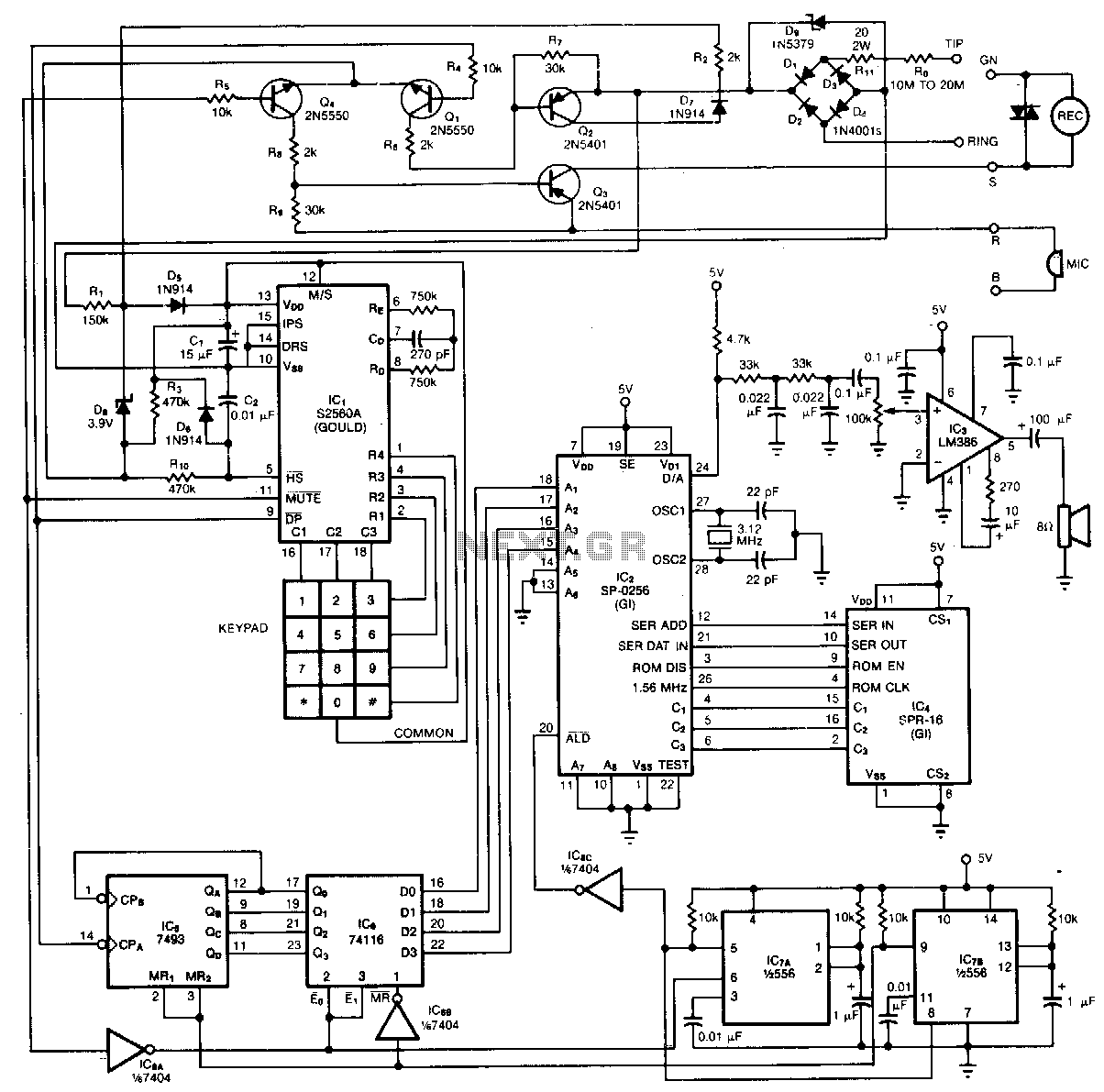
Dialed-phone-number-vocalizer

By vocalizing the numbers and symbols of its keypad, the phone provides audible confirmation that is useful to the blind. The serial interface, 2 K-byte x 8-bit ROM (IC4) stores programmed sequences of instructions that are executed by the speech processor chip IC2, manufactured by General Instrument Corp. When a key is depressed, the tone-dialing chip IC1 issues the corresponding number of pulses at its DP output. Counter IC5 totals the pulses, and IC6 latches the resulting 4-bit digital word. This word, converted to serial format by IC2, becomes an address that selects a block of memory within IC4.
The circuit described operates as an assistive technology device designed for individuals with visual impairments. The core functionality relies on a keypad that, when activated, provides audio feedback through a speech processor. The speech processor (IC2) is responsible for converting the digital signals generated by the keypad into audible speech. This is achieved by utilizing a programmed ROM (IC4) that contains pre-recorded sequences of audio signals corresponding to the keypad inputs.
When a user presses a key on the keypad, the tone-dialing chip (IC1) generates a series of pulses that represent the key pressed. Each pulse corresponds to a specific number or symbol, allowing the circuit to interpret user input accurately. The output from IC1 is then fed into a counter (IC5), which counts the number of pulses generated. This pulse count is critical for determining the exact input from the keypad.
Once the pulses are counted, the resulting data is latched by IC6, which captures the 4-bit digital word representing the input. This digital word is then processed by IC2, which converts it into a serial format suitable for addressing the ROM (IC4). The address generated by IC2 allows the system to retrieve the appropriate audio sequence from the ROM, which is then outputted through a speaker or similar audio device.
This system not only enhances accessibility for visually impaired users but also showcases the integration of various electronic components to create a functional assistive device. The combination of tone generation, counting, and audio playback illustrates the effective use of digital logic and signal processing in modern electronic design.By vocalizing the numbers and symbols of its~eypad, the phone provides an audible confirmation that is useful to the blind. The serial-interface, 2 K-byte x 8-bit ROM (!C4) stores programmed sequences of instructions that are executed by the speech-processor chip IC2-manufactured by the General Instrument Corp.
When you depress a key, tone-dialing chip ICl issues the corresponding number of pulses at its DP output. Counter IC5 totals the pulses, and IC6 latches the resulting 4-bit digital word. This word, converted to serial format by IC2, becomes an address that selects a block of memory within IC4. 🔗 External reference
The circuit described operates as an assistive technology device designed for individuals with visual impairments. The core functionality relies on a keypad that, when activated, provides audio feedback through a speech processor. The speech processor (IC2) is responsible for converting the digital signals generated by the keypad into audible speech. This is achieved by utilizing a programmed ROM (IC4) that contains pre-recorded sequences of audio signals corresponding to the keypad inputs.
When a user presses a key on the keypad, the tone-dialing chip (IC1) generates a series of pulses that represent the key pressed. Each pulse corresponds to a specific number or symbol, allowing the circuit to interpret user input accurately. The output from IC1 is then fed into a counter (IC5), which counts the number of pulses generated. This pulse count is critical for determining the exact input from the keypad.
Once the pulses are counted, the resulting data is latched by IC6, which captures the 4-bit digital word representing the input. This digital word is then processed by IC2, which converts it into a serial format suitable for addressing the ROM (IC4). The address generated by IC2 allows the system to retrieve the appropriate audio sequence from the ROM, which is then outputted through a speaker or similar audio device.
This system not only enhances accessibility for visually impaired users but also showcases the integration of various electronic components to create a functional assistive device. The combination of tone generation, counting, and audio playback illustrates the effective use of digital logic and signal processing in modern electronic design.By vocalizing the numbers and symbols of its~eypad, the phone provides an audible confirmation that is useful to the blind. The serial-interface, 2 K-byte x 8-bit ROM (!C4) stores programmed sequences of instructions that are executed by the speech-processor chip IC2-manufactured by the General Instrument Corp.
When you depress a key, tone-dialing chip ICl issues the corresponding number of pulses at its DP output. Counter IC5 totals the pulses, and IC6 latches the resulting 4-bit digital word. This word, converted to serial format by IC2, becomes an address that selects a block of memory within IC4. 🔗 External reference